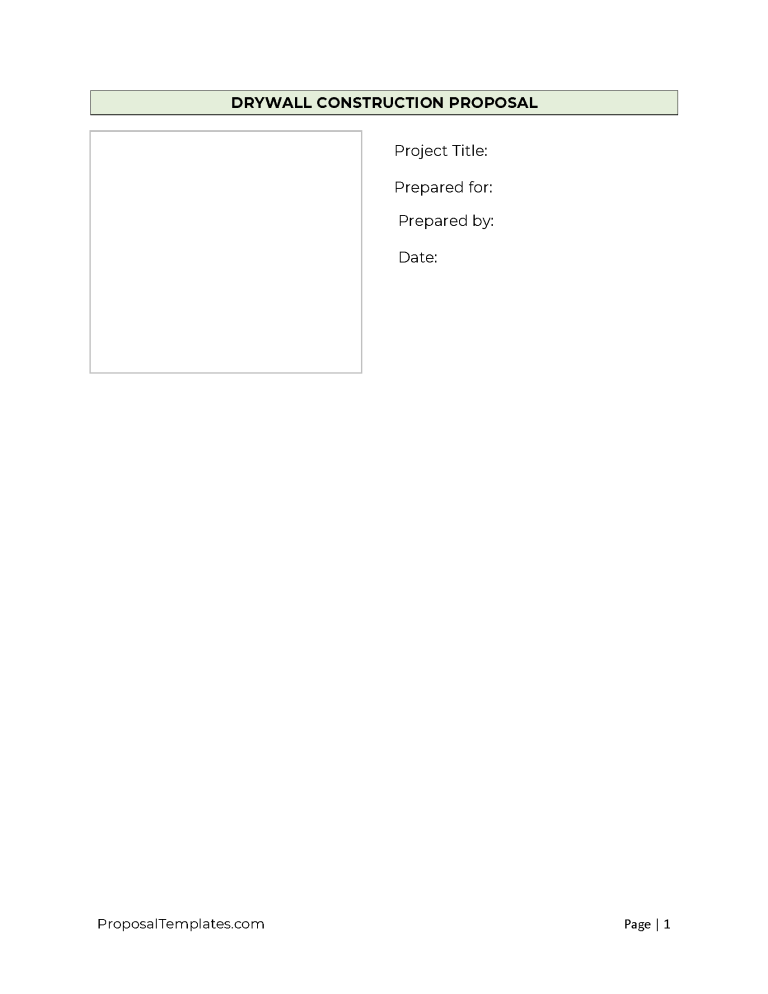A drywall proposal introduces potential clients to a company or contractor’s drywall installation and maintenance services. Drywall contractors or construction companies can communicate their qualifications for a client project by discussing topics such as the scope of the project, how they will complete it, and its estimated cost using a well-thought-out bid proposal.
Types Of Drywall Proposals (10)
- Ceiling Drywall Bid Proposal – A proposal that explains a drywall professional or construction company’s skill at drywall installations and repairs required for ceilings.
- Commercial Drywall Bid Proposal – A drywall construction proposal that is geared for commercial properties such as hotels, office buildings, and retail malls. Topics that assure the client that building and fire codes will be satisfied must be included.
- Custom Drywall Finishes Bid Proposal – The bid proposal is used for clients with specific requests for style, aesthetics, or structure.
- Drywall Repair and Patching Bid Proposal – This proposal is used for smaller projects that may or may not require full drywall installations but will require drywall repair or replacement.
- Fire-Rated Drywall Bid Proposal – A proposal that focuses on fire-rated drywall and all fireproofing measures the drywall construction business is adept at performing.
- Insulation and Drywall Bid Proposal – A proposal where the drywall construction business bids on a project that calls for installing drywall and insulation material. An analysis of the insulation used must accompany the drywalling skills and materials used by the company or independent contractor.
- New Construction Drywall Bid Proposal – This type of bid proposal is typically used for drywall installations and will focus on estimates for new drywall installations for a new structure or additions to an existing structure.
- Residential Drywall Bid Proposal – This bid is aimed at residential property owners such as homeowners, apartment buildings, and condominiums.
- Soundproofing Drywall Bid Proposal – This bid proposal focuses on a company’s ability to minimize sound traveling between rooms, accompanied by a section on the materials used and the company’s specialized process.
- Taping and Finishing Bid Proposal – The drywall construction proposal focuses on the last phases of a project.
What Should Be Included (13 Sections) |
1. Introduction
- Proposal Title, Date
- Project Title, Project Number
- Drywall Construction Business Name, Contact Information
- Client Name, Contact Information
- Project Project Summary
2. Project Description
- Drywall Project Materials
- Project Work Schedule
- Steps Required To Complete
3. Materials And Specifications
- Material/Supply Commercial Name
- Estimated Quantity, Adhesive Bonding
- Corner Beads, Joint Compound
- Cove Base, Bulkheads
- Sustainability, Unit Price
4. Timeline
- Drywall Project Date Range, Schedule
- Adaptability, Milestone, Duration
- Progress, Updates, Reporting, Client Approval
- Dates Of Significance To Project
5. Labor
Establish the labor requirements for this installation together with its anticipated work schedule. Additionally, submit the work dates and times with the drywall technicians’ pay rate. Also, identify all third parties directly involved.
- Drywall Technician Name, Expertise
- Craftsman, Safety-Trained Team
- Crew Collaboration, Reliability,
- Work Dates/Times, Pay Rate
6. Site Preparation
Document the condition of the drywall project site in detail. Discuss, in detail, the steps for preparing the site for the installation and those taken to ensure a safe and efficient clean-up process.
- Current Site Conditions, Site Clearing
- Preliminary Surface Priming, Surface Leveling
- Set Up Process, Foundation Inspection
- Insulation Installation, Layout, Planning, Soundproofing
- Clean Up Process, Demolition, Debris Removal
7. Installation Process
Describe how the drywall materials will be brought to the site and the steps needed for the installation (i.e., hanging, mounting, etc.). Additionally, highlight the kitchen remodeling team’s expertise and express confidence in the process.
- Installation Dates, Efficient Scheduling
- Cove Base, Trim Installation, Interior Wall Preperation
- Bulkheads, Soffit Construction, Insulation Integration
- Repairs, Patching
- Step-By-Step Description
8. Finishing And Texture
Describe the finishing process used on the drywall once properly installed on the project site. For example, define the schedule from procurement to drying, the costs, and safety precautions.
- Finishing Schedule, Precision, Process
- Quality, Texturing, Sanding, Smoothing
- Customization, Texture Matching, Blending
- Quality Assurance, Texture Repair
9. Waste Disposal
Expand upon the site’s clean-up or waste disposal process so the client will be confident in the final stages of the project. That is, define the labor, equipment, supplies, and safety procedures the kitchen remodeling business provides.
- Environmentally Friendly, Waste Management
- Recycling, Waste Segregation, Recylcling Drywall Waste
- Zero Waste Projects, Safe Disposal, Bulk Pickup
- Hazardous Waste Managment, Regulatory Compliance
10. Estimated Amounts
Give an estimated total for all the services, supplies, equipment, and permits, as well as warranties and follow-up maintenance services. To clarify, these estimates should be as inclusive and accurate as possible.
- Itemized Estimates, Transparent Cost Breakdown
- Competitive Rates, Customized Pricing
- Detailed Cost Projections, Upfront Drywall Project Quotes
- Affordability, Material Costs, Labor Costs
- Flexible Payment Options, Value-Based Proposal
11. Terms And Conditions
Explicitly define the timeline for payment. Additionally, provide all the payment options and requirements for this installation (such as deposits, partial payment, or warranties).
- Post-Service Options, Scope Of Work Agreement
- Dispute Resolution Terms, Cancellation, Refund Policies
- Insurance, Liability, Permitting, Regulatory Compliance
- Warrantee Terms, Client Responsibilities Agreement
- Client Approval, Building Code Compliance
12. Client Responsibilities
Outline all the responsibilities the client must fulfill for the drywall installation project, such as providing access to the site, scheduling, or providing materials and supplies for the technician.
- Client Schedule, Cooperation, Participation Requirements
- Site Accessibility, Coordination
- Communication, Participation Requirements
- Security Measures, Utilities Access
- Client-Supplied Materials, Safety Compliance

